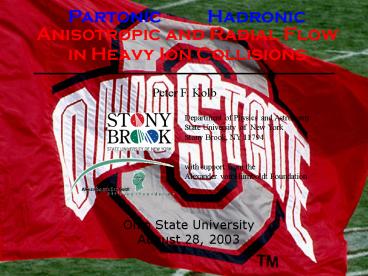Anisotropic and Radial Flow in Heavy Ion Collisions - PowerPoint PPT Presentation
1 / 27
Title:
Anisotropic and Radial Flow in Heavy Ion Collisions
Description:
Stony Brook, NY 11794. with support from the. Alexander von Humboldt Foundation. Peter F. Kolb ... S.Batsouli, S.Kelly, M.Gyulassy, J.L.Nagle, Phys. Lett. B ... – PowerPoint PPT presentation
Number of Views:201
Avg rating:3.0/5.0
Title: Anisotropic and Radial Flow in Heavy Ion Collisions
1
Anisotropic and Radial Flowin Heavy Ion
Collisions
Partonic Hadronic
Peter F. Kolb
Department of Physics and Astronomy State
University of New York Stony Brook, NY
11794 with support from the Alexander von
Humboldt Foundation
- Ohio State University
- August 28, 2003
2
Probing Properties of QCD in Nuclear Collisions
microscopic view
macroscopic view
vs
um
T
t
formalism
scattering of partons and hadrons kinetic
transport equations collision terms
continuity equations energy, momentum
conservation equation of state
3
Hydrodynamic Formalism
Equations of Motion
Equation of State
here a resonance gas EoS for Tcrit mixed phase and ideal gas EoS above
Initial Configuration
from an optical Glauber calculation
t0 0.6 fm
4
Non-Central Collisions Feature Broken Symmetry
Characterize azimuthal dependence of the
resulting observables by their Fourier expansion
With the given symmetries and the chosen
coordinate system
5
Which is converted to Momentum Space
quantify anisotropies
6
A short Digression on Fourier Coefficients
Distribution within the reaction plane
Distribution out of the reaction plane
for a delta-function like distribution
7
Which is converted to Momentum Space
quantify anisotropies
8
Elliptic Flow - A Prominent Observable
reaching the hydrodynamic limit
on a timescale indicating a soft transition region
heavier particles pick up larger in the
common flow field
9
Elliptic Flow at Large Pt is HUGE !
PHENIX Collaboration, nucl-ex/0305013
v2 0.25 means that there are 3 times as many
particles emitted into the reaction plane than
out of the reaction plane!Furthermore the
distribution is not elliptic any longer!
10
Higher order term to Counteract ?
develops a minimum in cartesian coordinates at
x0 for v2 0.1
To balance the minimum a v4 (10v2-1)/34 is
required (this brings the second derivative of
y(x) at x0 to vanish).
11
Traditional Expectations on v4
PFK, J. Sollfrank and U. Heinz, PLB 459 (1999) 667
Generally, v4 is expected to be very small
PFK, J. Sollfrank and U.Heinz, PLB 459 (1999) 667
This however is integrated over all momenta, and
thus biased to pT about 0.5 GeV ! Take a
differential look in pT as v2 is large at high
pT, you expect v4 to increase as well.
12
Differential Expectations on Higher vs
From a most recent calculation to describe
collisions at 200 GeV
PFK, and R. Rapp, PRC 67 (2003) 044903
It is however not sufficient to balance the
peanut shape
13
Anisotropies from a Black Lense
Carry the idea of Shuryak and Voloshin to higher
levels (higher orders)
PRC 66 (2002) 027902
NPA 715 (2003) 379
pure surface emission in the high pT limit (i.e.
from extreme jet-quenching)
14
Limiting Anisotropies versus Centrality
Extremely interesting centrality dependence
This picture predicts a peanut like distribution
as well!
15
Azimuthally Differential Particle Spectra
In three distinct directions
Unfortunately, finite widths in j reduce the
(small) signal further
16
Not Many Particles are Beyond 2 GeV !
G. Roland for the Phobos Collaboration, CIPANP
May 2003
More than 99 of the emitted particles are below
2 GeV !
17
Particle Spectra of Central Collisions
Data PHENIX NPA715(03)151 STAR NPA715(03)458
PHOBOS NPA715(03)510 BRAHMS NPA715(03)478 Hydro
-calculations including chemical potentials PFK
and R. Rapp, Phys. Rev. C 67 (03) 044903
Hydro parameters ?0 0.6 fm/c s0 110
fm-3 s0/n0 250 TcritTchem165 MeV
18
Single Particle Spectra L
H. Caines, STAR collab., talk at SQM 2003
19
Single Particle Spectra X
J. Castillo, STAR Collaboration, talk at HIC03
20
Single Particle Spectra W
C. Suire, STAR collab., Nucl. Phys. A 715 (2003)
470c
21
Blast Wave Fit to W s
C. Suire, STAR collab., Nucl. Phys. A 715 (2003)
470c
Schnedermann, Sollfrank, Heinz, PRC 48 (1993)
2462
22
Still more exotic Mesons with Heavy Quarks
PHENIX collab Phys. Rev. Lett. 88 (2002)
192303 S.Batsouli, S.Kelly, M.Gyulassy,
J.L.Nagle, Phys. Lett. B 557 (2003) 26
Single electron spectra from charm decay can be
described by PYTHIA, as well as by assuming
transverse flow of D and B mesons(blast wave
with T128 MeV and bmax0.65). Elliptic flow will
make a clear statement! (And such measurements
are coming!)
23
Summary Part 1- Partonic Collectivity
Anisotropies in heavy ion collisions
We learned a lot from v2 already
24
Summary Part 2 - Hadronic Collectivity
The fits indicate that strange hadrons prefer
higher freeze-out temperatures with smaller
radial flow than (anti)protons.
However, these are only parameters of fits to an
ambiguous (albeit physically motivated)
parameterization with an extremely strong (T,v)
correlation.
The slope of the (preliminary) strange particle
spectra can only be achieved if the strange
resonances further increase radial flow in the
resonance phase.
25
Summary Part 3 - Higher Harmonics
Still lots to gain from higher harmonics (and
triple differential spectra)
26
Supplements
27
Characteristic Shapes of the Series
Beware for large coefficients this terminology
is unappropriate !































